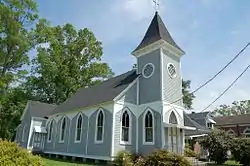Episcopal Church of the Incarnation
Episcopal Church of the Incarnation is a historic church at 111 E. Olive Street in Amite, Louisiana. It was built in 1872 and modified in 1908. It was added to the National Register in 1980.[1]
Episcopal Church of the Incarnation | |
 | |
  | |
| Location | 111 E. Olive St., Amite, Louisiana |
|---|---|
| Coordinates | 30°43′48″N 90°30′24″W |
| Area | 0.3 acres (0.12 ha) |
| Built | 1872, 1908 |
| Architectural style | Gothic Revival |
| NRHP reference No. | 80001759[1] |
| Added to NRHP | October 8, 1980 |
History
Prior to the establishment of a parish, the Episcopal community of Amite was served by missionary priests, including R. H. Ranney, Bishop Joseph Wilmer, and Edward Fontaine. In January 1871, Henry Forrester began to hold a monthly service. The parish was organized on February 25, 1871, under the name the "Church of the Incarnation". John M. Bach donated three lots for the construction of a church.[2]
In December 1872 the Herman Cope Duncan, missionary to this area, became the first rector,[3] and work immediately commenced on building the church. The interior woodwork was all dressed lumber. Parishioners contributed a chalice and paten. St. Peter's Church in Brooklyn donated a font. Christ Church (New Orleans) provided substantial assistance. Duncan resigned in August 1873 and was followed by a succession of rectors. By 1887, services were held on Wednesday night only.[2]
By 1908, the Church of the Incarnation was a mission church attended by J. W. Bleker. During the night of April 24, the church was destroyed in a tornado, which left only the chancel.[4] It was rebuilt, An example of small-town Gothic ecclesiastical architecture,[5] it was consecrated on December 3, 1916.[6]
The church is part of the Northshore Deanery of the Episcopal Diocese of Louisiana.[7]
NRHP designation
Its NRHP nomination describes:
The Church of the Incarnation is significant in the area of architecture as a superior example of small town, turn-of-the-century Gothic church architecture. Most extant examples have lancet windows and towers, but the Church of the Incarnation has the additional refinement of an elegant flared spire, exterior broad pointed arches accentuating the bays and quatrefoil ventilators.[8]
References
- "National Register Information System". National Register of Historic Places. National Park Service. November 2, 2013.
- Duncan, Herman Cope. "Church of the Incarnation, Amite", The Diocese of Louisiana, Some of Its History, 1838-1888: Also Some of the History of Its Parishes and Missions, 1805-1888, A.W. Hyatt, 1888, p. 212 et seq.
 This article incorporates text from this source, which is in the public domain.
This article incorporates text from this source, which is in the public domain. - Louisiana Department of Culture, Recreation and Tourism. "Church of the Incarnation".
- The Living Church, Volume 39, May 23, 1908. Milwaukee, Wisconsin. The Young Churchmen's Co., p. 144
- Sternberg, Mary Ann. The Pelican Guide to Louisiana, Pelican Publishing, 2002, p. 138ISBN 9781455610235
- Journal of the Seventy-Eighth Annual Session of the Council of the Diocese of Louisiana, 1917, p. 48
- "About the Diocese of Louisiana", Episcopalassetmap.org
- Vestry, Church of the Incarnation (June 1980). "National Register of Historic Places Inventory/Nomination: Episcopal Church of the Incarnation". National Park Service. Retrieved March 10, 2019. With accompanying photo from 1980